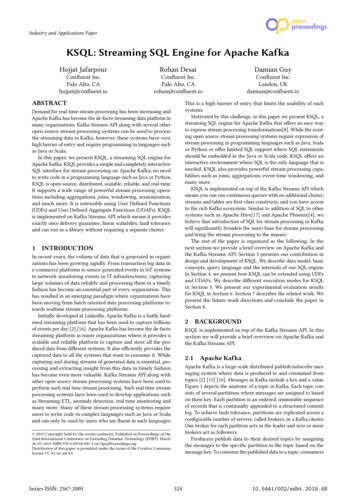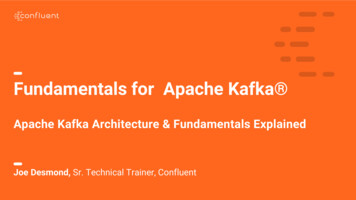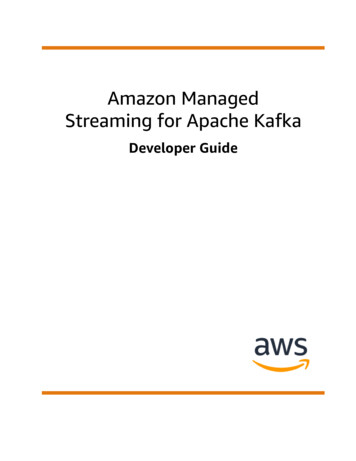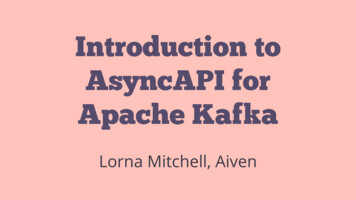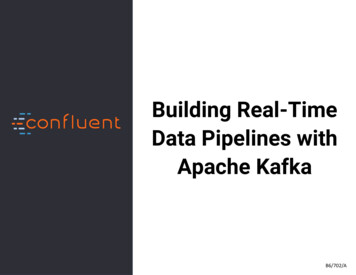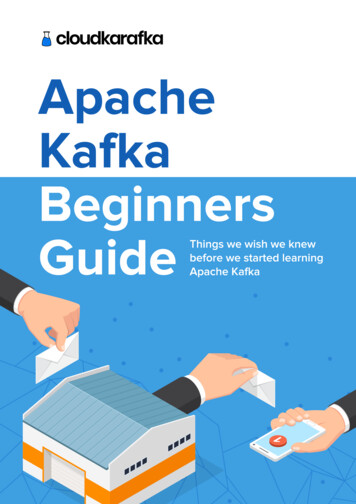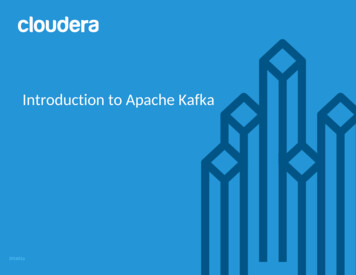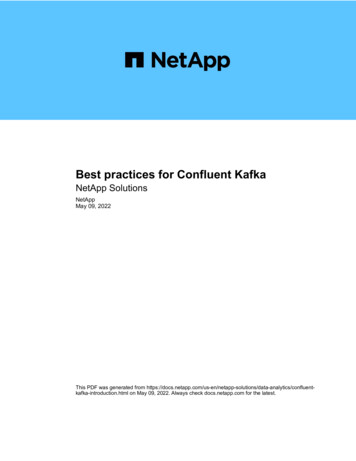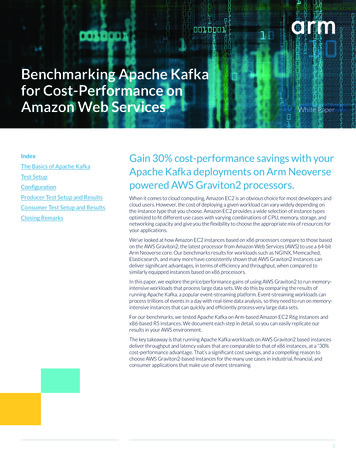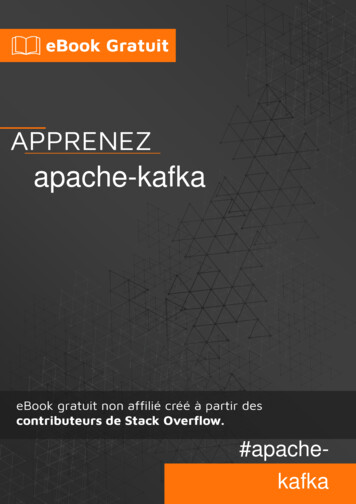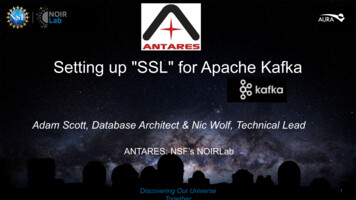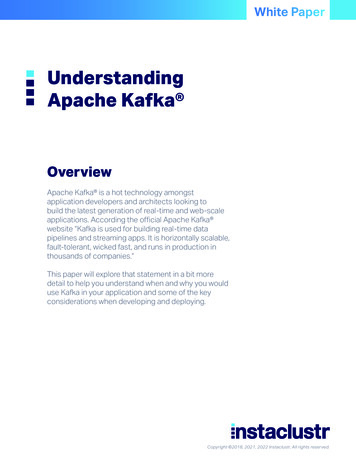
Transcription
White PaperUnderstandingApache Kafka OverviewApache Kafka is a hot technology amongstapplication developers and architects looking tobuild the latest generation of real-time and web-scaleapplications. According the official Apache Kafka website “Kafka is used for building real-time datapipelines and streaming apps. It is horizontally scalable,fault-tolerant, wicked fast, and runs in production inthousands of companies.”This paper will explore that statement in a bit moredetail to help you understand when and why you woulduse Kafka in your application and some of the keyconsiderations when developing and deploying.Copyright 2018, 2021, 2022 Instaclustr, All rights reserved.
Why Use a Queuing or Streaming Engine?Kafka is part of general family of technologies known as queuing, messaging, or streamingengines. Other examples in this broad technology family include traditional message queuetechnology such RabbitMQ, IBM MQ, and Microsoft Message Queue. It can be said thatKafka is to traditional queuing technologies as NoSQL technology is to traditional relationaldatabases.These newer technologies break through scalability and performance limitations of thetraditional solutions while meeting similar needs, Apache Kafka can also be compared toproprietary solutions offered by the big cloud providers such as AWS Kinesis, Google CloudDataflow, and Azure Stream Analytics.The wealth of very popular options in this family of technologies is clear evidence ofreal and widespread need. However, it may not be immediately obvious what role thesetechnologies play in an architecture. Why would I want to stick some other complicatedthing in between the source of my events and the consumers that use the events? To smooth and increase reliability in the face of temporary spikes in workload.That is to deal gracefully with temporary incoming message rate greater thanprocessing app can deal with by quickly and safely storing the message until theprocessing system catches up and can clear the backlog. The engineers at Slack havepublished an excellent blog post explaining how they use Kafka for just this purpose intheir architecture: -687222e9d100An extension to this buffering case is where the consuming application is completelyunavailable. In this case the queuing solution can keep receiving messages fromconsumers and retain them until the consuming application comes back online. Anexample of this case might be an IoT application—the devices sending readings arenot going to stop sending information because your processing system is down orunder maintenance. However, the messages can be stored in a queue and processedonce the outage is finished. To increase flexibility in your application architecture by completely decouplingapplications that produce events from the applications that consume them.This is particularly important to successfully implementing a microservices architecture,the current state of the art in application architectures. By using a queuing system,applications that a producing events simply publish them to a named queue andapplication that are interested in the events consume them off the queue. The publisherand then consumer don’t need to know anything about each other expect for thename of the queue and the message schema. There can be one or many producerspublishing the same kind of message to the queue and one or many consumer taclustr2
the message and neither side will care.To illustrate this, consider an architecture where you initially have a web front end thatcaptures new customer details and some backend process that stores these details ina database. By putting a queue in the middle and posting “new customer” events to thatqueue I can, without changing existing code, do things like: add an new API application that accepts customer registrations from a new partner andposts them to the queue; or add a new consumer application that registers the customer in a CRM system.Instaclustr’s Kongo series of blog posts provides some very detail examples andconsiderations when architecting an application this way.Why Use Kafka?The objectives we’ve mentioned above can be achieved with a range of technologies. Sowhy would you use Kafka rather than one of those other technologies for your use case? It’s highly scalable It’s highly reliable due to built in replication, supporting true always-on operations It’s Apache Foundation open source with a strong community Built-in optimizations such as compression and message batching It has a strong reputation for being used by leading organizations.For example: LinkedIn (orginator), Pinterest, AirBnB, Datadog, Rabobank, Twitter,Netflix (see https://kafka.apache.org/powered-by for more) It has a rich ecosystem around it including many connectorsThese properties (and others) of Kafka lead to be suitable for additional architecturalfunctions compared to the broad family of queuing and streaming engines. In particular,Kafka can be used as: A distributed log store in a Kappa architectureIn this model, the message stored in Kafka are the definitive source of truth for yourapplication. You may use database, caches, and other mechanism to provide viewsof the state for performance reasons but these can always be recreated from themessage stored. This architecture has significant advances for auditability andrecovering from taclustr3
A stream processing enginePerforming calculations on streams (to provider a simple example—calculating anaverage value over the last 5 messages or 5 minutes) is a complex, specialist problembest supported by an architectural framework that allows you to focus on your businesslogic. The Kafka Streams library provides this stream processing framework for usewith Kafka.Looking Under the HoodLet’s take a look at how Kafka achieves all this:We’ll start with PRODUCERS. Producers are the applications that generate events andpublish them to Kafka. Of course, they don’t randomly generate events—they create theevents based on interactions with people, things, or systems. For example a mobile appcould generate an event when someone clicks on a button, an IoT device could generatean event when a reading occurs, or an API application could generate an event when calledby another application (in fact, it is likely an API application would sit between a mobile appor IoT device and Kafka). These producer applications use a Kafka producer library (similarin concept to a database driver) to send events to Kafka with libraries available for Java, C/C , Python, Go, and .NET.The next component to understand is the CONSUMERS. Consumers are applications thatread the event from Kafka and perform some processing on them. Like producers, they canbe written in various languages using the Kafka client libraries.The core of the system is the Kafka BROKERS. When people talk about a Kafka clusterthey are typically talking about the cluster of brokers. The brokers receive events from theproducer and reliably store them so they can be read by consumers.The brokers are configured with TOPICS. Topics are a bit like tables in a database,separating different types of data. Each topic is split into PARTITIONS. When an eventis received, a record is appended to the log file for the topic and partition that the eventbelongs to (as determined by the metadata provided by the producer). Each of thepartitions that make up a topic are allocated to the brokers in the cluster. This allows eachbroker to share the processing of a topic. When a topic is created, it can be configured tobe replicated multiple times across the cluster so that the data is still available for even if aserver fails. For each partition, there is a single leader broker at any point in time that servesall reads and writes. The leader is responsible for synchronizing with the replicas. If theleader fails, Kafka will automatically transfer leader responsibility for its partitions to one ofthe replicas.As well as reliability, this topic and partition schema has implications for scalability. clustr4
can be as many active brokers receiving and providing events as there are partitions in thetopic so, provided sufficient partitions are configured, Kafka clusters can be scaled-out toprovider increased processing throughput.In some instances, guaranteed ordering of message delivery is important so that eventsare consumed in the same order they are produced. Kafka can support this guarantee atthe topic level. To facilitate this, consumer applications are placed in consumer groups andwithin a CONSUMER GROUP a partition is associated with only a single consumer instanceper consumer group.The following diagram illustrates all these Kafka concepts and their relationships:Operating KafkaA Kafka cluster is a complex distributed system with many configuration propertiesand possible interactions between components in the system. Operated well, Kafkacan operate at the highest levels of reliability even in relatively unreliable infrastructureenvironments such as the aclustr5
At a high level, the principles for successfully operating Kafka are the same as otherdistributed server systems: choose hardware and operating system configuration that is appropriate for thecharacteristics of the system have a monitoring system in place, and understand and alert on the key metrics thatindicate the health of the system have documented and tested procedures (or better yet, automated processes) fordealing with failures, and consider, test, and monitor security of your configuration.Specifically for Kafka you need to consider factors such as appropriate choice of topicsand partitions, placement of brokers into racks aligned with failure domains and placement,and configuration of Apache ZooKeeperTM. Our white paper on Ten Rules for ManagingKafka provides a great primer on the key considerations. Visit our Resource section todownload the same.Instaclustr Managed KafkaAt Instaclustr, we are specialists in operating distributed systems to provide reliabilityat scale. We have more than 100 million node hours of experience managed ApacheCassandra and Apache SparkTM and have chosen to extend our offering to include ApacheKafka as a managed service.We chose to add Kafka to our offering for a number of reasons: Kafka, like Cassandra and Spark, is used when you need to build applications thatsupport the highest levels of reliability and scale. The three technologies are often usedtogether in a single application. The applications demand the same mission criticallevels of service from a managed service provider. Kafka is Apache Foundation open source software with a massive user community—the software is maintained under a robust governance model ensuring it is not overlyinfluenced by commercial interests and that users can freely use the software as theyneed to. There are no licensing fees and no vendor lock-in. Kafka has many architectural similarities to Cassandra and Spark allowing us toleverage our operational experience such as tuning and troubleshooting JVMs, dealingwith public cloud environments and their idiosyncrasies and operating according toSOC 2 principles for a secure and robust m@instaclustr6
We see Apache Kafka as a core capability for our architectural strategyas we scale our business. Getting set up with Instaclustr’s Kafka servicewas easy and significantly accelerated our timelines. Instaclustr consultingservices were also instrumental in helping us understand how to properlyuse Kafka in our architecture.Glen McRae, CTO, LendiAs very happy users of Instaclustr’s Cassandra and Spark managedservices, we’re excited about the new Apache Kafka managed service.Instaclustr quickly got us up and running with Kafka and provided thesupport we needed throughout the process.Mike Rogers, CTO, SiteMinderAboutInstaclustrInstaclustr helps organizations deliver applications at scale through its managed platform for opensource technologies such as Apache Cassandra , Apache Kafka , Apache Spark , Redis ,OpenSearch , PostgreSQL , and Cadence.Instaclustr combines a complete data infrastructure environment with hands-on technology expertiseto ensure ongoing performance and optimization. By removing the infrastructure complexity, weenable companies to focus internal development and operational resources on building cutting edgecustomer-facing applications at lower cost. Instaclustr customers include some of the largest andmost innovative Fortune 500 companies. 2021 Instaclustr Copyright Apache , Apache Cassandra , Apache Kafka , Apache Spark , and Apache ZooKeeper are trademarks of The Apache Software Foundation. Elasticsearch and Kibana are trademarks forElasticsearch BV. Kubernetes is a registered trademark of the Linux Foundation. OpenSearch is a registered trademark of Amazon Web Services. Postgres , PostgreSQL and the Slonik Logo are trademarks or registered trademarksof the PostgreSQL Community Association of Canada, and used with their permission. Redis is a trademark of Redis Labs Ltd. *Any rights therein are reserved to Redis Labs Ltd. Cadence is a trademark of Uber Technologies, Inc.Any use by Instaclustr Pty Limited is for referential purposes only and does not indicate any sponsorship, endorsement or affiliation between Redis and Instaclustr Pty Limited. All product and service names used in this website are foridentification purposes only and do not imply m@instaclustr7
Apache Kafka Overview Apache Kafka is a hot technology amongst application developers and architects looking to build the latest generation of real-time and web-scale applications. According the official Apache Kafka website “Kafka is used for building real-time data p
